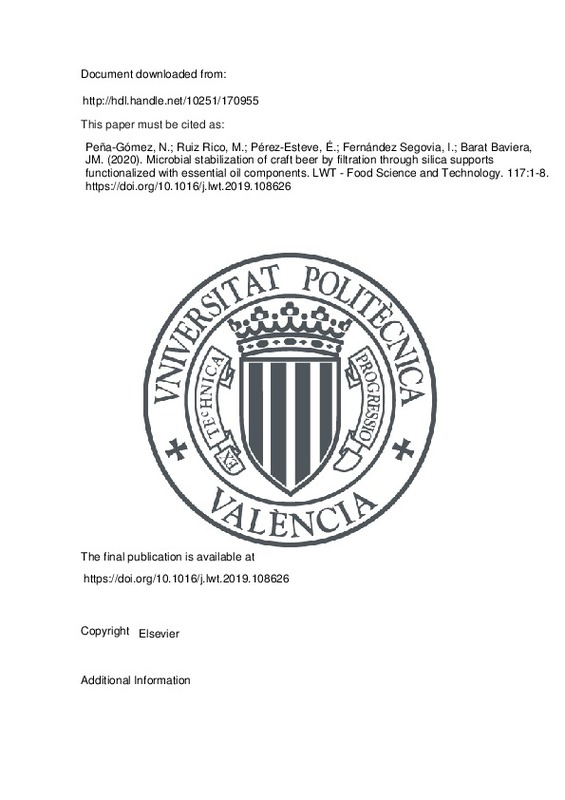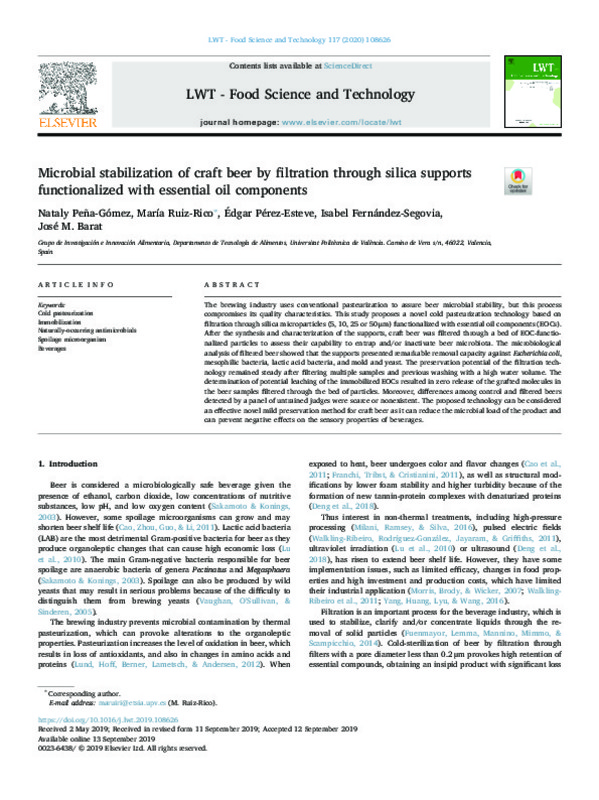Burt, S. (2004). Essential oils: their antibacterial properties and potential applications in foods—a review. International Journal of Food Microbiology, 94(3), 223-253. doi:10.1016/j.ijfoodmicro.2004.03.022
Cao, L., Zhou, G., Guo, P., & Li, Y. (2011). Influence of Pasteurising Intensity on Beer Flavour Stability. Journal of the Institute of Brewing, 117(4), 587-592. doi:10.1002/j.2050-0416.2011.tb00508.x
Chavan, P. S., & Tupe, S. G. (2014). Antifungal activity and mechanism of action of carvacrol and thymol against vineyard and wine spoilage yeasts. Food Control, 46, 115-120. doi:10.1016/j.foodcont.2014.05.007
[+]
Burt, S. (2004). Essential oils: their antibacterial properties and potential applications in foods—a review. International Journal of Food Microbiology, 94(3), 223-253. doi:10.1016/j.ijfoodmicro.2004.03.022
Cao, L., Zhou, G., Guo, P., & Li, Y. (2011). Influence of Pasteurising Intensity on Beer Flavour Stability. Journal of the Institute of Brewing, 117(4), 587-592. doi:10.1002/j.2050-0416.2011.tb00508.x
Chavan, P. S., & Tupe, S. G. (2014). Antifungal activity and mechanism of action of carvacrol and thymol against vineyard and wine spoilage yeasts. Food Control, 46, 115-120. doi:10.1016/j.foodcont.2014.05.007
Deng, Y., Bi, H., Yin, H., Yu, J., Dong, J., Yang, M., & Ma, Y. (2018). Influence of ultrasound assisted thermal processing on the physicochemical and sensorial properties of beer. Ultrasonics Sonochemistry, 40, 166-173. doi:10.1016/j.ultsonch.2017.07.017
Devi, R., Alemayehu, E., Singh, V., Kumar, A., & Mengistie, E. (2008). Removal of fluoride, arsenic and coliform bacteria by modified homemade filter media from drinking water. Bioresource Technology, 99(7), 2269-2274. doi:10.1016/j.biortech.2007.05.002
Fillaudeau, L., & Carrère, H. (2002). Yeast cells, beer composition and mean pore diameter impacts on fouling and retention during cross-flow filtration of beer with ceramic membranes. Journal of Membrane Science, 196(1), 39-57. doi:10.1016/s0376-7388(01)00568-3
Franchi, M. A., Tribst, A. A. L., & Cristianini, M. (2011). Effects of High Pressure Homogenization on Beer Quality Attributes. Journal of the Institute of Brewing, 117(2), 195-198. doi:10.1002/j.2050-0416.2011.tb00460.x
Fuenmayor, C. A., Lemma, S. M., Mannino, S., Mimmo, T., & Scampicchio, M. (2014). Filtration of apple juice by nylon nanofibrous membranes. Journal of Food Engineering, 122, 110-116. doi:10.1016/j.jfoodeng.2013.08.038
Gialleli, A.-I., Bekatorou, A., Kanellaki, M., Nigam, P., & Koutinas, A. A. (2016). Apple juice preservation through microbial adsorption by nano/micro-tubular cellulose. Innovative Food Science & Emerging Technologies, 33, 416-421. doi:10.1016/j.ifset.2015.11.006
Gil, G., del Mónaco, S., Cerrutti, P., & Galvagno, M. (2004). Selective antimicrobial activity of chitosan on beer spoilage bacteria and brewing yeasts. Biotechnology Letters, 26(7), 569-574. doi:10.1023/b:bile.0000021957.37426.9b
Holley, R. A., & Patel, D. (2005). Improvement in shelf-life and safety of perishable foods by plant essential oils and smoke antimicrobials. Food Microbiology, 22(4), 273-292. doi:10.1016/j.fm.2004.08.006
Hyldgaard, M., Mygind, T., & Meyer, R. L. (2012). Essential Oils in Food Preservation: Mode of Action, Synergies, and Interactions with Food Matrix Components. Frontiers in Microbiology, 3. doi:10.3389/fmicb.2012.00012
Lu, G., Li, C., Liu, P., Cui, H., Yao, Y., & Zhang, Q. (2010). UV inactivation of microorganisms in beer by a novel thin-film apparatus. Food Control, 21(10), 1312-1317. doi:10.1016/j.foodcont.2010.03.007
Lund, M. N., Hoff, S., Berner, T. S., Lametsch, R., & Andersen, M. L. (2012). Effect of Pasteurization on the Protein Composition and Oxidative Stability of Beer during Storage. Journal of Agricultural and Food Chemistry, 60(50), 12362-12370. doi:10.1021/jf303044a
Milani, E. A., Ramsey, J. G., & Silva, F. V. M. (2016). High pressure processing and thermosonication of beer: Comparing the energy requirements and Saccharomyces cerevisiae ascospores inactivation with thermal processing and modeling. Journal of Food Engineering, 181, 35-41. doi:10.1016/j.jfoodeng.2016.02.023
Morris, C., Brody, A. L., & Wicker, L. (2007). Non-thermal food processing/preservation technologies: a review with packaging implications. Packaging Technology and Science, 20(4), 275-286. doi:10.1002/pts.789
Ribes, S., Ruiz-Rico, M., Pérez-Esteve, É., Fuentes, A., Talens, P., Martínez-Máñez, R., & Barat, J. M. (2017). Eugenol and thymol immobilised on mesoporous silica-based material as an innovative antifungal system: Application in strawberry jam. Food Control, 81, 181-188. doi:10.1016/j.foodcont.2017.06.006
Rota, M. C., Herrera, A., Martínez, R. M., Sotomayor, J. A., & Jordán, M. J. (2008). Antimicrobial activity and chemical composition of Thymus vulgaris, Thymus zygis and Thymus hyemalis essential oils. Food Control, 19(7), 681-687. doi:10.1016/j.foodcont.2007.07.007
Ruiz-Rico, M., Pérez-Esteve, É., Bernardos, A., Sancenón, F., Martínez-Máñez, R., Marcos, M. D., & Barat, J. M. (2017). Enhanced antimicrobial activity of essential oil components immobilized on silica particles. Food Chemistry, 233, 228-236. doi:10.1016/j.foodchem.2017.04.118
Sakamoto, K., & Konings, W. N. (2003). Beer spoilage bacteria and hop resistance. International Journal of Food Microbiology, 89(2-3), 105-124. doi:10.1016/s0168-1605(03)00153-3
Valente, I. M., Santos, C. M., Moreira, M. M., & Rodrigues, J. A. (2013). New application of the QuEChERS methodology for the determination of volatile phenols in beverages by liquid chromatography. Journal of Chromatography A, 1271(1), 27-32. doi:10.1016/j.chroma.2012.11.026
Vaughan, A., O’Sullivan, T., & Sinderen, D. (2005). Enhancing the Microbiological Stability of Malt and Beer - A Review. Journal of the Institute of Brewing, 111(4), 355-371. doi:10.1002/j.2050-0416.2005.tb00221.x
Walkling-Ribeiro, M., Rodríguez-González, O., Jayaram, S. H., & Griffiths, M. W. (2011). Processing temperature, alcohol and carbonation levels and their impact on pulsed electric fields (PEF) mitigation of selected characteristic microorganisms in beer. Food Research International, 44(8), 2524-2533. doi:10.1016/j.foodres.2011.01.046
Yang, N., Huang, K., Lyu, C., & Wang, J. (2016). Pulsed electric field technology in the manufacturing processes of wine, beer, and rice wine: A review. Food Control, 61, 28-38. doi:10.1016/j.foodcont.2015.09.022
[-]










